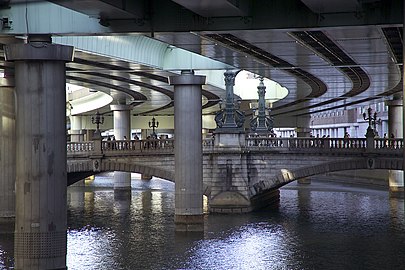Tsumaki Yorinaka
Tsumaki Yorinaka | |
|---|---|
 Tsumaki Yorinaka | |
| Born | 22 February 1859 Tokyo, Japan |
| Died | 10 October 1916 (aged 57) Tokyo, Japan |
| Nationality | Japanese |
| Alma mater | Imperial College of Engineering, Cornell University |
| Occupation | Architect |
| Design | Nihonbashi Bridge (1911) |
Tsumaki Yorinaka (妻木 頼黄, February 22, 1859—October 10, 1916) was a Japanese architect and Head of the Japanese Ministry of Finance building section in the later Meiji period.
Credited with the design of many significant Meiji era structures in Japan, notably the Nihonbashi Bridge.
Early life and career
[edit]Together with Katayama Tokuma, Tatsuno Kingo, Sone Tatsuzō and Satachi Shichijiro, one of a group of renowned architectural students at the Imperial College of Engineering, Tokyo, and a protege of British architect Josiah Conder.
Tsumaki continued his studies in the United States where he graduated with a degree in Architecture from Cornell University in 1894. He then travelled to Berlin for further study in the same field, working at the same time in the architectural offices of Wilhelm Böckmann and Hermann Ende.[1]
Buildings and Structures
[edit]- Sugamo Prison (1896)[2]
- Handa Red Brick Building (1898)
- Yokohama Specie Bank, Yokohama Head Office (1904). Since 1968 the building has been used as the Kanagawa Prefectural Museum of Cultural History
- Yokohama Specie Bank Dalian Branch (1909). Currently the Dalian branch of the Bank of China.
- Yokohama Red Brick Warehouse No. 2 Building (1911)
- Nihonbashi Bridge (1911)
-
Nihonbashi Bridge, shortly after opening in 1911
-
Nihonbashi Bridge, with the Shuto Expressway pictured overhead, 2007
References
[edit]- ^ Checkland, Olive (2003). Japan and Britain After 1859: Creating Cultural Bridges. New York: RoutledgeCurzon. p. 82. ISBN 0-203-22183-4.
- ^ Botsman, Daniel (2007). Punishment and Power in the Making of Modern Japan. Princeton University Press. p. 196. ISBN 978-0-691-13030-9.
External links
[edit] Media related to Tsumaki Yorinaka at Wikimedia Commons
Media related to Tsumaki Yorinaka at Wikimedia Commons


